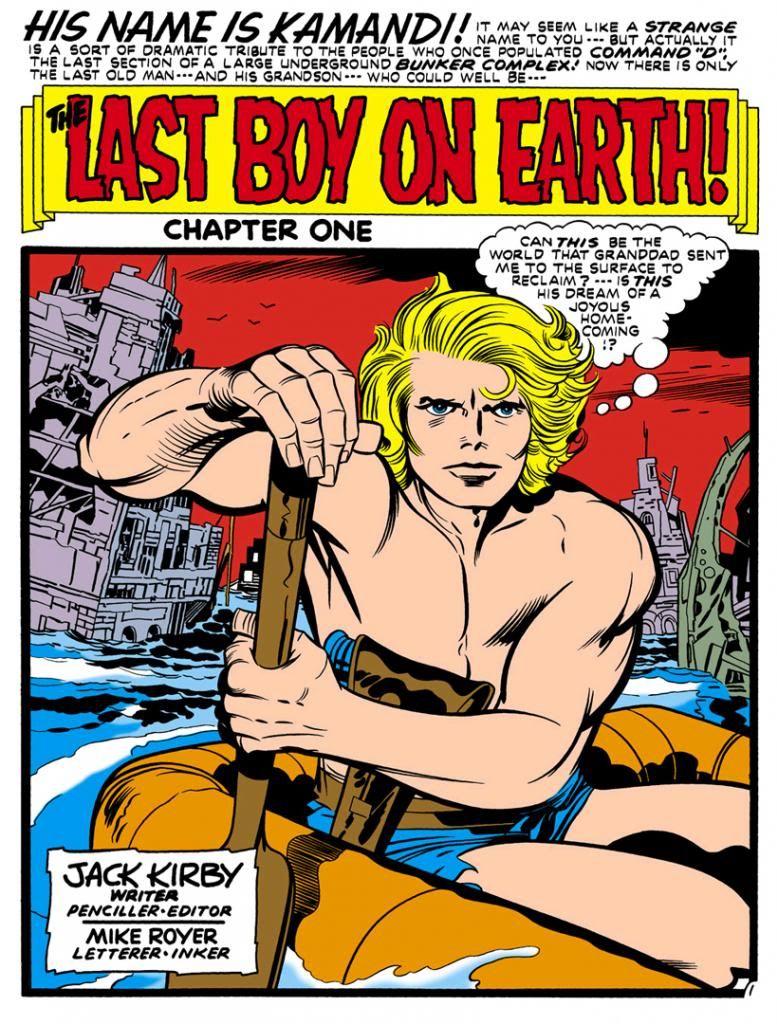Wednesday, April 3, 2013
Don't Ask: Just Read It! April is Kamandi Month!
There are many things I love and two of the things I love most-- as close friends know-- are Jack Kirby and Planet of the Apes. Sometimes the things I love don't quite fit together, like Kirby layouts and Alex Toth pencils on X-Men #12. But every so often they combine into a third thing I also end up loving. So it was when Cornelius met the King. Kind of.
I've always heard Kamandi resulted when Carmine Infantino asked Kirby to do something like Planet of the Apes. And no wonder-- the films set off a huge merchandise boom that pre-figured the one for Star Wars-- action figures, playsets, garbage cans, board games, coloring books; everything an Apes-happy kid could want. So it's easy to see why Infantino would want to put DC in the talking ape business (also, DC has a long history with apes).
Eventually, Marvel landed the Apes license and produced eleven issues of a monthly series and twenty-nine of a black and white magazine. Neither book drew more than a cultish following, but on another DC-style earth (Earth-K), Infantino worked a deal with 20th Century Fox and Kirby drew the first five or so issues of DC's Planet of the Apes (along the lines of the 2001 adaptation he later produced for Marvel here in our reality) before handing it off to Mark Evanier and a rotating cast of artists.
Go seek out that black hole that's spinning almost at the speed of light. It'll take you right to this fabulous universe, where Kirby's Fourth World epic went exactly as he'd planned it and his Planet of the Apes ran for 150-odd issues and witnessed the art debuts of both Michael Golden and Frank Miller and an annual written by Alan Moore. Bring some of those comics back with you, too. I'd like to read them!
But here in our world, things didn't work out that way. Denied by 20th Century Fox but stuck on his idea, Infantino cancelled Forever People, ripping a hole in the Fourth World, and then put Kirby to work on a derivative tale of talking apes and the end of the world.
How lucky for us Kirby could never contain himself to mere imitation. Instead, he took some old concepts he had rattling around and worked them into a post-apocalyptic tale in his own style, with a rambunctious long-haired teen as its lead and more than just talking apes as villains. In Kamandi's world, not just apes but animals of all kinds talk. They have little kingdoms of their own and wage interspecies war against each other with Kamandi frequently caught between the furred factions.
Marvel's Apes tales, written by Doug Moench and initially drawn by Mike Ploog, went beyond the meagre budgetary considerations of the movie series and gave us all kinds of weird vistas. Giant brains floating in tanks, apes acting like 19th century mountain men, an adventure inside Mount Rushmore, bionic apes. And those crazy city-ships. Kirby's vision was even more expansive, covering the entirety of North and parts of South America, germs from space, radioactive astronauts, Kamandi as a jockey on the back of a horse-sized grasshopper, the fevered paranoia of Richard Nixon and my favorite-- Chicagoland, a Prohibition-era museum city populated by robots enacting all the classic gangster stereotypes of the era.
While Moench's "Terror on the Planet of the Apes" opus features Jason, one of comics' true assholes, as its human lead, Kirby's book stars a young man billed as "The Last Boy on Earth." His name comes from the bunker in which he lived with his grandfather, but his looks and personality are made up of purest Kirby.
Actually, Kamandi resembles any number of young dudes who used to terrify me back when I was a kid in the deep south. I mean, obviously we had modern swimming pools way down there in Georgia, but these guys-- and their girlfriends-- also liked swimming in rivers, lakes and "blue holes," where underground aquifers bubbled up in the form of cold springs. Or tubing down creeks. And their swimwear of choice was usually cut-off blue jeans just like the ones Kamandi sports. Like those guys, Kamandi's a roughneck who takes no guff from anyone. Not from lion kings, panther princes, or angry ape sergeants. With his quick temper and shirtless style, Kamandi would fit right in with these Lynyrd Skynyrd-loving southern boys.
He's prettier, though. Look at his glorious hair, the kind even Farrah Fawcett-Majors would have envied in her Charlie's Angels heyday.
And a heck of a lot smarter. Kamandi's got brains. He doesn't just experience his world and fight against it; he searches for answers to all its mysteries. The "Last Boy on Earth" (as the book's subtitle calls him), Kamandi journeys largely alone through Kirby's madcap future, always on the lookout for others like himself and the ultimate answer to how things got so mixed up in the first place. Cortexin, huh?
For the next few weeks, we're going to spend some time with Kamandi and really get to know him, his friends and his world. Come along with me, won't you? Let's close our eyes, drift into comas for hundreds of years and awaken in the future, after the Great Disaster. Humanity has abandoned its cities and fled into the forests. The ascendency of animal-kind has arrived.
Now-- open your eyes.
What do you see?
Subscribe to:
Post Comments (Atom)


No comments:
Post a Comment